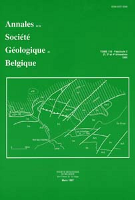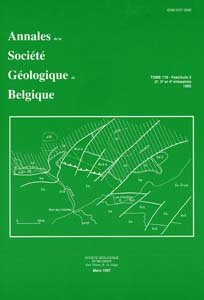- Home
- Volume 112 (1989)
- Fascicule 2 (Tectonique actuelle et récente en Bel...
- Tectonique cassante et néotectonique
View(s): 2554 (12 ULiège)
Download(s): 7908 (34 ULiège)
Tectonique cassante et néotectonique

Résumé
L'étude des déformations récentes porte principalement sur le domaine cassant. L'analyse de la tectonique cassante trouve un fil directeur essentiel dans la reconstitution des états de contrainte à partir des populations de jeux de failles ou de mécanismes au foyer des séismes. La reconstitution locale des orientations des axes des paléocontraintes σ1,σ2,σ3 et d'un rapport Φ lié à la forme de l'ellipsoïde des contraintes fait appel à des méthodes graphiques et numériques; l'analyse quantitative doit s'accompagner d'une étude qualitative poussée, notamment pour les tectoniques polyphasées.
On passe du stade local au stade régional en corrélant les états de paléocontrainte d'une même phase; si le réseau des déterminations locales est assez dense, des cartes des trajectoires de la paléocontrainte extrême subhorizontale sont tracées. L'étape ultime consiste à interpréter ces résultats régionaux dans le cadre géodynamique d'ensemble, en reliant la dynamique (champs de contraintes) à la cinématique (mouvements relatifs et déformation). Cette démarche est illustrée pour un exemple de compression associée à une collision (Taiwan) et pour un exemple d'extension associée à une subduction (Egée). En outre, l'exemple de la plate-forme européenne dans le cadre de la collision Afrique-Europe illustre l'intérêt de l'étude de la tectonique cassante en termes de paléocontraintes dans les zones stables et sa liaison avec la reconstitution cinématique aux frontières de plaques.
Cette étude débouche sur une définition de la néotectonique fondée sur la continuité et l'homogénéité d'un mécanisme géodynamique régional, conduisant par exemple à une période néotectonique de 2-4 Ma pour Taiwan et de 12-13 Ma pour l'Egée. Cette acception n'exclut pas des interruptions mineures ou des réorientations illustrées par des rotations significatives des trajectoires de contrainte accompagnant des modifications cinématiques. L'analyse des mécanismes cassants, effectuée à toutes les échelles et en termes de contraintes, apporte un outil de choix et un fil directeur à l'étude néotectonique.
Abstract
The study of recent deformation concerns the brittle tectonic domain principally. Paleostress regimes are reconstructed accurately based on mechanical analyses of fault slip data sets collected in the field, or of focal mechanisms of earthquakes reconstituted with seismic records. In this paper, it is claimed that such mechanical analyses provide a powerful tool to understand brittle tectonics. In the first section, the basic principles and techniques for paleostress reconstruction using fault slip data sets are discussed in a general way (details are given in other papers). In the second section, the case of focal mechanisms of earthquakes is presented, because neotectonic studies generally include seismotectonic aspects; contrasts and similarities between fault and earthquake mechanisms are especially discussed from the methodological point of view. Some examples are illustrated, including paleostress analyses of simple monophase sites as well as complex polyphase ones, and stress analysis of a group of earthquakes.
Local determinations of paleostresses (or present stresses for active faulting or seismicity) are made based on graphical and numerical analyses of fault slips. Data include fault plane orientations as well as directions and senses of slips. Such data maybe processed regardless of the origin of faults, neoformed or inherited (Fig.1). However, identification of neoformed faults (including the common conjugate systems) brings additional constraints, resulting in possibilities to get more information and to carry out rapid preliminary analyses (Fig.2). Because data consist of orientations and senses, not magnitudes, the results are obtained in terms of reduced stress tensors (Fig. 3, 4 and 5). These results consist of (1) the orientations of the three principal stress axes σ1,σ2 and σ3, and (2) the ratio Φ of principal stress differences, Φ = (σ2-σ3)/(σ1-σ3). Note that σ1 designs the maximum compressional stress and σ3 the minimum stress (σ1, ≥ σ2 ≥ σ3); Φ values thus range from 0 to 1. The orientation of the stress ellipsoid depends on three independent variables, while its shape and size depend on three other independent variables (Fig. 6): Φ (defined before), k (positive scale factor) and I (isotropic stress).
To determine k and I, further analyses are needed in terms of rock mechanics. The importance of careful qualitative analysis in the field is pointed out, especially where fault patterns are polyphase (a common occurrence). Analyses of fault slip data in monophase and polyphase settings are illustrated through case examples (Fig.7 and 8, respectively).
The comparison between fault slip and earthquake mechanism data sets independently collected by geologists and geophysicists (Fig. 9) reveals strong analogy (Fig. 10) and significant differences (Fig. 11). A simple robust method, the P and T dihedra method, is applicable in both cases (Fig. 12 and 13). Stress tensor determination by numerical means allows more accurate determination of stress with focal mechanisms of earthquakes (Fig. 14), but requires preliminary choice among nodal planes of each datum.
The third section of this paper shows the significance of such stress-paleostress analyses at the regional scale. In order to reconstruct regional paleostress patterns, it is indispensable first to obtain a dense network of local determinations, and second to establish correlations between paleostresses related to a single tectonic event throughout the area under investigation. Paleostress trajectory maps are thus obtained. The last step consists of integrating these results within the geodynamic framework. Such studies finally allow comparisons between regional dynamics (paleostress fields) and kinematics (plate relative motion and intraplate deformation). This kind of analysis is briefly illustrated through three main examples: first, the regional compression related to arc-continent collision in Taiwan where a recent orogen is growing (Fig. 15 and 16, Plate I); second, the more complex relationship between widespread extension that affects the upper plate of a subduction zone in the Hellenic Arc (Fig. 17 and 18, Plate II); third, the distribution of intraplate stress in the European platform considered as a key to understand the kinematics of Africa-Eurasia convergence during the Cenozoic (Fig. 19). The european case example also demonstrates that the analysis of brittle tectonics brings a powerful tool for geodynamic studies even in very poorly deformed platform domains, because minor fracturation and faulting reliably reflect remote boundary conditions.
Finally, the best definition of «neotectonics» is based on the continuity and the homogeneity of regional geodynamic mechanisms, rather than on arbitrary chronostratigraphic subdivision. As a result, from region to region, the neotectonic period may vary depending on the age of the geodynamic mechanism which still prevails: 2-4 Ma in Taiwan 12-13 Ma in Aegea. This definition of neotectonics does not preclude second order interruptions or reorientations. Such second order changes may involve for instance significant rotations of paleostress trajectory trends related to kinematic modifications, as in Taiwan and Aegea. Paleostress analyses of brittle tectonics at all scales provide an efficient key to investigate such second-order tectonic evolution as well as to identify the time-space extent of first-order geodynamic mechanisms.
To cite this article
About: Jacques Angelier
Tectonique Quantitative, Université Pierre et Marie Curie, Tour 26 - E1, 4, place Jussieu, 75252 PARIS Cedex 05, et URA 1315 du CNRS.






